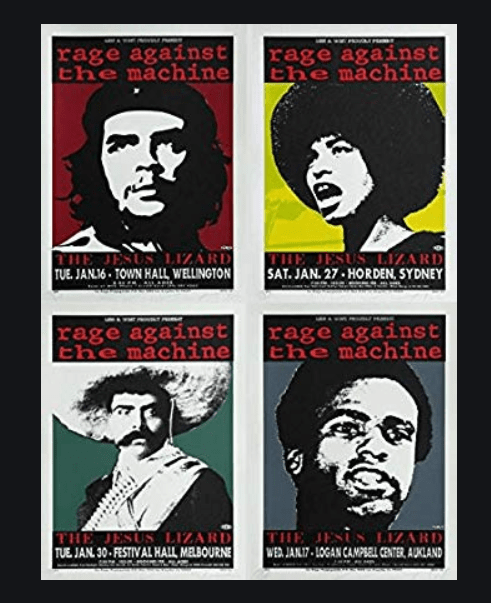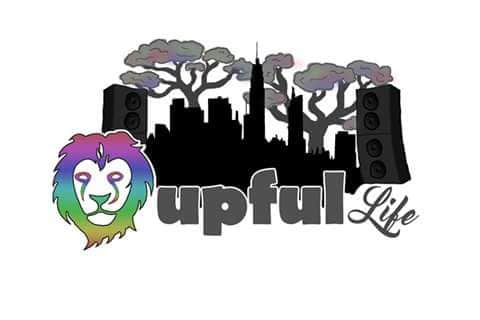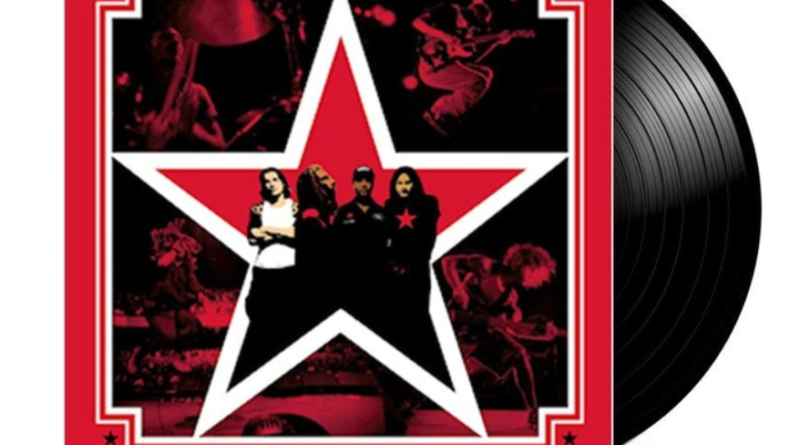RAGE AGAINST THE MACHINE’S LAST STAND- Live at Grand Olympic Auditorium [B.Getz on JamBase]
For a little over seven years, Rage Against the Machine was the world’s most dangerous band. Their ascent was arduous and their reign brief and tumultuous, but while they lasted, simply no band could touch them. The Los Angeles quintet burst onto the rock scene in 1992 with an uncompromising eponymous debut album and hard line socialist politics to match. The world was awakened by their sound: greasy hip-hop crunch and dirge-like metal riffs, hard ‘n’ funky breaks, and simple dynamics. A fiery MC moved the crowd, made them listen just long enough until his band mates made them bounce. Words like “revolutionary” were often used to describe the band, its ideals, and its music. Their reputation was uncompromising and their sound was defined by power.
Said power can be traced to three entities: a mercilessly heavy and funky rhythm section, comprised of drummer Brad Wilk and bassist Tim Commerford, aka YtimK. Headsplitting crunch ordained a head nodding chemistry; they made metal funky as it gets without sacrificing brutality. Guitarist Tom Morello is truly an anomaly. His steez rooted in ’70s rock riffing, head full of ideals born within the punk community, the virtuoso guitarist is an amalgam of both, with some millennial wah-wah gangbang thrown in for good measure. His turntablism on guitar and manipulation of the toggle switch were light years before its time and the tightrope he walked between guitars, pedals, effects, feedback, and other assorted tactics earned him respect in various arenas of rock guitar. Morello’s development paralleled the band’s, unearthing a bevy of imitators and separating Rage from the countless bands that tried to use the rap/rock blueprint. These members of Rage created hip-hop/metal (“Walk this Way” and “Bring the Noise” were novelties). Unfortunately, it opened the floodgates to less inspired, carbon copy rap/rock (see Limp Bizkit, Crazy Town), a development RATM sheepishly tried to ignore for the duration of its existence, which may have hastened its demise.

And then there was vocalist Zach de la Rocha–the introverted, enigmatic, firebreathing punker emcee. His voice is unmistakable, the messages loud and clear due to its brutal and convincing delivery. Like Morello, no one had ever seen the likes of de la Rocha before, a dreaded rapping punk singer who invited comparisons to Marley and Mackaye. He was the front man, the whirling dervish of rhyme, spitting fire on record and at the world. A veteran of LA punk and avid student of golden era hip-hop, de la Rocha was an activist MC before Dead Prez ever picked up a mic.
A whirlwind of sound, politics, energy, and power chords, Rage Against the Machine ascended to the top of the bloated post-Nirvana rock kingdom. They did so utilizing a primitive sonic landscape and carved out a genre all their own with their own weapons of mass destruction: guitar, bass, drums, and vocals unaided by programming, keyboards, or production tinkering. RATM set afire much of the contrived alt-rock of the ’90s, and the world had not enjoyed such a band since London’s The Clash 15 years earlier.
Despite its success, Rage was always a work in progress, constantly pent with intense dialogue and communication breakdowns within the band and with its label, Sony Music. The L.A. group’s internal conflicts and great achievements made for a disastrous recipe. Rage could always be counted on for controversial social action, championing causes that range from support for jailed Native American Leonard Peltier and concerts for convicted cop-killer Mumia Abu-Jamal to fund raising for Central American militias and Socialist organizations. Like the Clash before them, a threadbare cohesion allowed the four musicians to write and perform, the group utilizing the volatile interpersonal dynamic to its advantage in concocting bombastic revolution on record. This tactic came to define the band’s creative process, resulting in many a long hiatus between albums and touring, and a dramatic upward curve in the quality of product and performance. As the Nineties came to a close, those same aggressive juices that drove them to produce such progressive, electro-charged records devolved into an insurmountable communication/creative impasse. After the tour with GangStarr behind their third album, 2000’s scorching Battle of Los Angeles (produced by “modern day Mo Ostin” Rick Rubin), de la Rocha left to pursue a then-seemingly bright future as a solo artist.
Equal parts Black Sabbath, Public Enemy, and the MC5, RATM performing live cemented the notion of being the world’s most dangerous band. In the live element, they simply couldn’t be touched. RATM stole stages from mega-heavyweights, toured a summer with an unraveling Wu-Tang Clan, went toe-to-toe with Metallica at the musically-orgasmic, socially-catastrophic Woodstock ’99, and whipped the 2000 Democratic National Convention in Los Angeles into a veritable frenzy before the riot cops pulled the plug. Shortly after the convention, Rage played two small shows in home city L.A. that would prove to be their last. In a move that was a long time coming yet shocking when it happened, de la Rocha quit the band. The band’s final two shows are chronicled on their recently released swan song Live at the Grand Olympia Auditorium. Simply stated, there is no more appropriate way to celebrate this behemoth of a band. Recorded over two shows, September 2000 12-13 in L.A., these shows are RATM in their finest hour. Though they didn’t know for sure these would be their last shows, they sure played like they did: tight changes, loose grooves, overwhelming robust bottom end, and the infectious vocals of ZDLR. The recording captures the essence of RATM. The final show from 9/13/00 was released on DVD soon after the CD compilation.
On his fan website www.zdlr.net, de la Rocha commented on the final Rage Against the Machine releases. “After watching both the Olympic Grand Auditorium and the Democratic National Convention concert footage, I can think of no other moments in all of our 10 years as a band that captured the intensity and the intent of Rage Against the Machine.”
The disc is a solid hour-plus of pure, rugged Rage, barreling through much of their catalogue, possibly with the intent to destroy it (a few covers are thrown in to keep it interesting). The CD opens with the crunching wah-wah/stop-start intercourse that is “Bulls on Parade” (1996’s Evil Empire), the microphone explodes, and by the time Morello starts his solo stabbing and scratching like DJ Premier, the adrenaline rush is two-thirds through the body. The socially conscious call to action “Bullet in the Head” (1994’s self-titled debut) still resonates strongly, what with the cloud hanging over the Bush Administration and its globally regressive policies. Morello is the man taking liberties here, bringing the onslaught with a deadly descending riff. The song crushes along its way, de la Rocha repeating the song’s title threat, his wail wrought with anger, fear, and empowerment. “Calm Like a Bomb” (Battle of L.A., 2000) illustrates the quartet’s growth, the song clearly more dynamic and interesting then some of their more skeletal compositions. Zach’s abusive poetics had gravitated to profoundly cloaked entendres and rhymes; during “Calm” his metaphoric visions raise the bar even higher. As the complexities of song structure and sonic personality reach for the heavens, Tim and Brad lock in dubwise beat science and de la Rocha rips off some of his trademark flow. Each song nearly identical to its album version, Rage holds steadfast their organic creations when they perform.
A number of songs that could have been included were left off in lieu of a pair of marginally performed covers. EPMD’s “I’m Housin'” appears as a testament to one of Zach’s favorite New York rap groups, and a homage to the Detroit political rockers MC5 arrives in the form of their anthem “Kick Out the Jams.” Though these selections are not necessarily bad, more originals would only serve to strengthen the live CD. Picking up the pace in the middle of the disc is the teen-angst anthem “Killing in the Name Of,” which again seems poignant given the worldwide unrest that smatters the front pages today. This gem stutter-steps its eerie rhythms and explodes like a Molotov cocktail, with Wilk’s skin bashing egging on the most vicious of tones from Tom Morello. And “Fuck you I won’t do what you tell me!” still works!
The disc concludes with a trifecta of three of Rage’s finest and most brutal songs. “Know Your Enemy” begins with funky hip-hop flavor but metastasizes into punked-out Tommy Iommi mayhem, with de la Rocha pleading the refrain “All of which are American dreams!” over a chunky-as-fuck Morello bludgeoning. “No Shelter,” originally released on the Godzilla soundtrack, is possibly RATM at their most realized. Commerford’s intricate bass and Wilk’s shuffle snare set the tone here–stutterstep funk with some electro-groove–and then Morello jumps in with a dagger-like riff (Wu-tang Razor Sharp!) that sets Zack off, spitting out an American nightmare. When the boys lock in on the monster bridge that slams into submission, ZDLR screams “Shut Down” with a helpless abandon that evokes Armageddon. “No Shelter” may be the finest cut on the CD.
There is no better song for RATM to close a show, or a career, than the one that put them on the map, the crushing “Freedom.” The song serves as inspiration for the oppressed, for those wrongly accused and dubiously convicted, for those in the struggle or those who have overcome, and the song is the O.G. of RATM songs, where it all begins. The power of this song has not diminished at all, as again evidenced by its uncompromising strength and the slow-deep groove every rap-rock band has ever longed for. To conclude their career with “Freedom,” ZDLR flows like a soloist, the trio behind him painting rebellion with a pleasurable grimace. The head bangs, the lyrics roll off the tongues of an enthralled Los Angeles faithful, and for one last bounce, slam, bang, and flail of the locks, there is “Freedom!”
After the demise of RATM, the three musicians in the band made a move to the more melodic, radio friendly rock outfit Audioslave, along with former Soundgarden frontman Chris Cornell. De la Rocha, on the other hand, has been a recluse of sorts, reportedly working with ?uestlove, DJ Shadow, and Youth on his long-anticipated solo endeavor.
B. Getz
JamBase | East Coast
Go See Live Music!
originally published 4/21/2004

